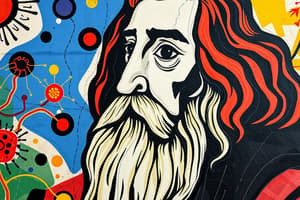Podcast
Questions and Answers
Who was the first to observe bacteria and protozoa using a microscope?
Who was the first to observe bacteria and protozoa using a microscope?
- Lazzaro Spallanzani
- Louis Pasteur
- Anton van Leeuwenhoek (correct)
- Robert Koch
What did Lazzaro Spallanzani experiment with in his research?
What did Lazzaro Spallanzani experiment with in his research?
- Heating techniques
- Plant and animal species
- Broth in sealed and unsealed jars (correct)
- Different types of lenses
What was Anton van Leeuwenhoek's contribution to microbiology?
What was Anton van Leeuwenhoek's contribution to microbiology?
- He was the first to observe living microbes. (correct)
- He created a theory on spontaneous generation.
- He developed the first antibiotic.
- He discovered how to cultivate bacteria.
What were the magnification capabilities of Leeuwenhoek's single-lens microscope?
What were the magnification capabilities of Leeuwenhoek's single-lens microscope?
Which conclusion did Lazzaro Spallanzani disagree with?
Which conclusion did Lazzaro Spallanzani disagree with?
What is the primary action of yeast in alcoholic fermentation?
What is the primary action of yeast in alcoholic fermentation?
What was one of Joseph Lister's significant contributions to surgery?
What was one of Joseph Lister's significant contributions to surgery?
What process involves killing harmful microbes by heating liquids at high temperatures for a short time?
What process involves killing harmful microbes by heating liquids at high temperatures for a short time?
Ferdinand Cohn is notable for his work in which area of microbiology?
Ferdinand Cohn is notable for his work in which area of microbiology?
What does 'pasteurizing' substances refer to in the context of disease prevention?
What does 'pasteurizing' substances refer to in the context of disease prevention?
What role does oxygen play in aerobic respiration?
What role does oxygen play in aerobic respiration?
Why is oxygen considered toxic for obligate anaerobes?
Why is oxygen considered toxic for obligate anaerobes?
Which process is primarily driven by the transfer of high-energy electrons?
Which process is primarily driven by the transfer of high-energy electrons?
What type of organisms rely on oxygen for their metabolic processes?
What type of organisms rely on oxygen for their metabolic processes?
What characterizes toxic forms of oxygen?
What characterizes toxic forms of oxygen?
Which aspect of microbial physiology primarily deals with how organisms cope with changes in their environment?
Which aspect of microbial physiology primarily deals with how organisms cope with changes in their environment?
What is a significant ecological role of bacteria in ecosystems?
What is a significant ecological role of bacteria in ecosystems?
Which of the following bacteria is known for its use as a pesticide in insect pest control?
Which of the following bacteria is known for its use as a pesticide in insect pest control?
What is the primary application of Pseudomonas putida in environmental management?
What is the primary application of Pseudomonas putida in environmental management?
Which area of study focuses on the heritable information in microorganisms?
Which area of study focuses on the heritable information in microorganisms?
What occurs during the stationary phase of population growth?
What occurs during the stationary phase of population growth?
Which category do organisms that utilize light as an energy source fall into?
Which category do organisms that utilize light as an energy source fall into?
Why is nitrogen important for cells?
Why is nitrogen important for cells?
What is one mode by which most photosynthetic organisms handle nitrate?
What is one mode by which most photosynthetic organisms handle nitrate?
Which of the following is characteristic of chemotrophs?
Which of the following is characteristic of chemotrophs?
What role does sulfur play in cellular processes?
What role does sulfur play in cellular processes?
Which group of organisms rely on organic compounds for their energy needs?
Which group of organisms rely on organic compounds for their energy needs?
What is the significance of recycling nitrogen within cells?
What is the significance of recycling nitrogen within cells?
Flashcards are hidden until you start studying
Study Notes
Historical Figures in Microbiology
- Anton van Leeuwenhoek first observed bacteria and protozoa in 1674 using a microscope, which magnified objects 50-300x.
- Lazzaro Spallanzani conducted experiments with sealed and unsealed jars of broth, challenging prevailing theories about spontaneous generation.
- Louis Pasteur discovered that fermentation occurs due to yeast and bacteria, laying groundwork for germ theory and vaccination.
Pasteur's Contributions
- Developed pasteurization, a method of heating liquids to eliminate harmful microbes, transforming food safety.
- Conducted significant work on vaccines, notably the rabies vaccine in 1885.
- Introduced antiseptic techniques in surgery with carbolic acid to reduce postoperative infections.
Microbial Biology Topics
- Microbial physiology focuses on how microorganisms adapt to environmental changes affecting their metabolism and stress responses.
- Microbial genetics explores heritable information mechanisms in microorganisms, facilitating advances in biotechnology.
- Microbial ecology examines the relationships between organisms and their environment, including nutrient recycling and ecosystem roles.
Applications of Microbes
- Bacteria serve as primary decomposers, recycling nutrients back into the ecosystem.
- Bacillus thuringiensis is used for insect pest control, being toxic to certain larvae.
- Pseudomonas putida aids in bioremediation, effectively cleaning up petroleum spills.
Energy Sources for Microorganisms
- Organisms are categorized as phototrophs or chemotrophs:
- Phototrophs utilize light for energy, primarily seen in photosynthetic bacteria.
- Chemotrophs obtain energy from chemical compounds, relying on redox reactions for metabolism.
Role of Nitrogen in Cellular Processes
- Nitrogen is crucial for synthesizing amino acids and nucleotides, which are vital for protein and nucleic acid production.
- Most organisms recycle nitrogen within their metabolic processes.
Significance of Oxygen in Microbiology
- Oxygen is essential for obligate aerobes as the final electron acceptor in ATP production through aerobic respiration.
- In contrast, obligate anaerobes find oxygen toxic, using alternative metabolic pathways.
- The transfer of high-energy electrons is critical for cellular functions, including respiration and energy storage.
Growth Dynamics of Microorganisms
- Microbial growth curves typically exhibit a stationary phase, where population growth decreases and stabilizes under specific conditions.
Studying That Suits You
Use AI to generate personalized quizzes and flashcards to suit your learning preferences.




